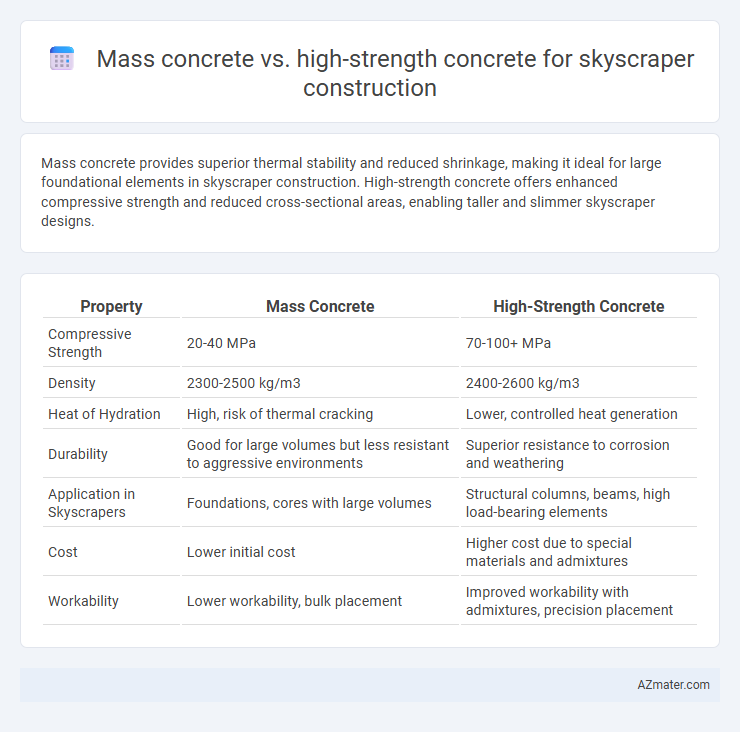Mass concrete provides superior thermal stability and reduced shrinkage, making it ideal for large foundational elements in skyscraper construction. High-strength concrete offers enhanced compressive strength and reduced cross-sectional areas, enabling taller and slimmer skyscraper designs.
Table of Comparison
| Property | Mass Concrete | High-Strength Concrete |
|---|---|---|
| Compressive Strength | 20-40 MPa | 70-100+ MPa |
| Density | 2300-2500 kg/m3 | 2400-2600 kg/m3 |
| Heat of Hydration | High, risk of thermal cracking | Lower, controlled heat generation |
| Durability | Good for large volumes but less resistant to aggressive environments | Superior resistance to corrosion and weathering |
| Application in Skyscrapers | Foundations, cores with large volumes | Structural columns, beams, high load-bearing elements |
| Cost | Lower initial cost | Higher cost due to special materials and admixtures |
| Workability | Lower workability, bulk placement | Improved workability with admixtures, precision placement |
Understanding Mass Concrete and High-Strength Concrete
Mass concrete, characterized by its large volume and low heat of hydration, is primarily used for foundational elements to minimize thermal cracking and ensure structural stability in skyscrapers. High-strength concrete, with compressive strengths often exceeding 6000 psi, provides enhanced load-bearing capacity and reduced cross-sectional areas, making it ideal for vertical columns and core walls in tall buildings. Choosing between mass and high-strength concrete depends on factors like structural demands, thermal management, and project-specific performance requirements in skyscraper construction.
Key Differences in Material Composition
Mass concrete utilizes a lower cement content with higher aggregate volume, emphasizing thermal management and reducing heat of hydration to prevent cracking in large pours. High-strength concrete incorporates a higher proportion of cement, silica fume, and admixtures like superplasticizers to achieve compressive strengths exceeding 6,000 psi, essential for supporting the intense load demands of skyscraper frameworks. The distinct mix designs reflect their specific structural roles, with mass concrete prioritizing volume stability and high-strength concrete focusing on enhanced durability and load-bearing capacity.
Structural Requirements for Skyscraper Construction
Mass concrete provides excellent load-bearing capacity and thermal stability essential for skyscraper foundations but often lacks the compressive strength needed for high-rise structural frames. High-strength concrete, with compressive strengths exceeding 6000 psi, enables slimmer columns and reduced material usage, enhancing vertical load support and seismic resistance in skyscraper construction. Structural requirements prioritize high-strength concrete for superstructure elements due to its superior durability and ability to withstand significant tensile and compressive stresses in tall buildings.
Load-Bearing Capacity Comparison
Mass concrete offers substantial load-bearing capacity ideal for foundational and basal skyscraper elements, supporting extensive gravitational and lateral forces through its dense composition. High-strength concrete exhibits significantly greater compressive strength, often exceeding 70 MPa, enabling slimmer columns and reduced structural weight while maintaining superior load distribution. Optimizing skyscraper design involves balancing mass concrete's durability and thermal stability with high-strength concrete's enhanced load-bearing efficiency for heightened structural performance.
Thermal Performance and Heat Management
Mass concrete in skyscraper construction excels at thermal inertia, absorbing and slowly releasing heat to stabilize indoor temperatures, which reduces HVAC energy loads during daily temperature cycles. High-strength concrete, with its denser matrix and lower porosity, offers less natural heat dissipation but provides superior mechanical performance, necessitating enhanced cooling measures to manage exothermic hydration heat during curing. Effective heat management in skyscraper projects often combines mass concrete's thermal buffering qualities with strategic use of high-strength concrete elements, optimizing both structural integrity and energy efficiency.
Durability and Longevity Under Stress
Mass concrete provides exceptional durability and longevity for skyscraper foundations due to its ability to resist thermal cracking and manage heat of hydration effectively, ensuring structural stability over time. High-strength concrete offers superior compressive strength and enhanced resistance to environmental stressors such as wind loads and seismic forces, contributing to the overall resilience of tall buildings. Selecting between mass concrete and high-strength concrete depends on the specific structural demands and long-term performance requirements under continuous stress conditions.
Construction Speed and Complexity
Mass concrete offers rapid placement and cost efficiency for skyscraper foundations, enabling faster initial construction phases due to its lower material strength requirements and simpler mix design. High-strength concrete, while more complex to produce and place because of its specialized additives and stricter curing processes, allows for slimmer structural elements and faster vertical progression by supporting higher loads and reducing column sizes. The choice between mass concrete and high-strength concrete impacts construction speed and complexity, with high-strength concrete favoring accelerated erection at the expense of increased technical demands.
Cost Implications and Project Budgeting
Mass concrete offers lower material costs and simpler mixing procedures, making it a budget-friendly option for large-volume applications in skyscraper foundations and cores. High-strength concrete, though more expensive due to its specialized admixtures and cement content, allows for reduced structural dimensions and overall weight, resulting in potential savings on steel reinforcement and foundation size. Project budgeting must balance immediate material costs against long-term structural efficiency and labor savings when choosing between mass and high-strength concrete for optimal financial outcomes.
Sustainability and Environmental Impact
Mass concrete used in skyscraper construction offers significant thermal mass benefits, reducing energy consumption for heating and cooling, which enhances sustainability by lowering the building's carbon footprint. High-strength concrete, while requiring less material due to its superior load-bearing capacity, often involves higher cement content, leading to increased CO2 emissions during production. Optimizing the mix design of high-strength concrete with supplementary cementitious materials, such as fly ash or slag, can improve its environmental performance and make it a more sustainable choice for high-rise structures.
Choosing the Right Concrete for Tall Building Projects
Mass concrete offers excellent thermal stability and cost efficiency for foundational elements in skyscraper construction, while high-strength concrete provides superior load-bearing capacity and reduced cross-sectional areas essential for tall building frameworks. Selecting the appropriate concrete hinges on project-specific factors such as structural demands, environmental conditions, and construction timelines. Optimizing concrete type ensures durability, safety, and economic viability in skyscraper design and execution.

Infographic: Mass concrete vs High-strength concrete for Skyscraper construction
 azmater.com
azmater.com